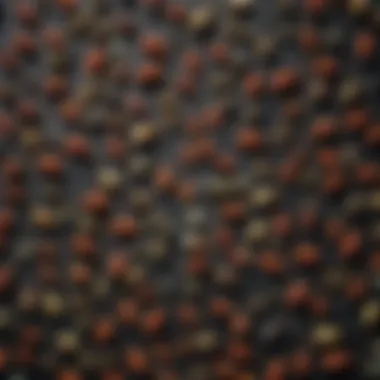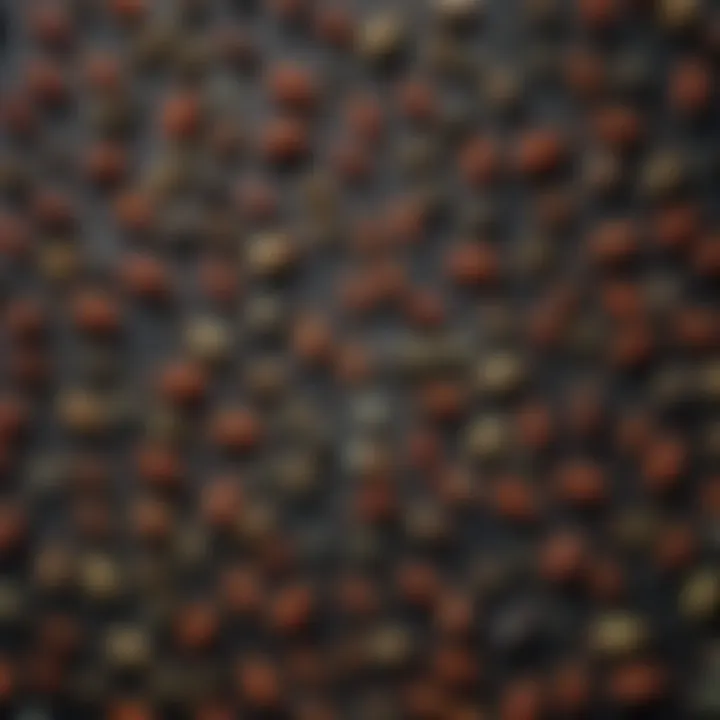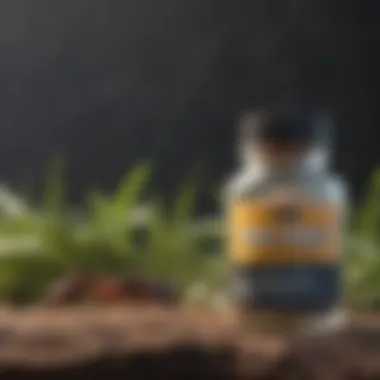What is the Best Ant Bait to Use for Effective Control


Intro
Ants can be a common nuisance in households and gardens, often causing distress for homeowners. This article aims to dissect the complexities of ant baits, providing essential insights into what products can effectively manage ant infestations. We will explore different types of ant baits, how they function, and what makes them suitable for various ant species. Furthermore, we will consider eco-friendly alternatives and practical application methods that can enhance results.
Understanding Pests
Definition of Pests
Pests are organisms that can cause harm or nuisance to humans, their properties, or their crops. Ants fall within this category, as certain species can invade homes and gardens, searching for food and shelter. Their behavior often leads to sanitation issues and structural damage, making them significant pests.
Importance of Pest Identification
Identifying the specific species of ants is pivotal before selecting a control method. Different species have varied feeding habits and reproductive rates. For instance, Carpenter ants are known for nesting in wood, while Sugar ants seek sugary substances. Understanding these distinctions allows for more targeted and effective bait selection, ensuring that the chosen product addresses the issue head-on.
Prevention Techniques
Home and Garden Preventative Measures
Prevention is key in managing ant populations. Here are a few effective strategies:
- Seal Entry Points: Inspect your home for cracks and crevices where ants might enter. Sealing these gaps can significantly reduce the chances of infestation.
- Maintain Cleanliness: Regular cleaning of surfaces can help eliminate food particles that attract ants. Pay special attention to kitchens and dining areas.
- Gardening Practices: Keep outdoor areas tidy. Remove unnecessary debris and maintain healthy soil conditions to discourage nesting.
Seasonal Prevention Tips
Ant behavior can change with the seasons. During warmer months, they are more active and in search of food. To prevent infestations, consider these tips:
- Spring Cleaning: Declutter and tidy both indoors and outdoors. This reduces hiding spots for ants.
- Fall Preparations: Check for entry points as ants will seek warmth indoors as temperatures drop.
Eco-Friendly Pest Control Solutions
Overview of Sustainable Practices
Sustainability is becoming a focal point in pest control. Many homeowners now prefer eco-friendly options that minimize harm to the environment. Products that are biodegradable or have natural ingredients should be considered. Such options reduce chemical exposure, making them safer for families and pets.
Natural Remedies and Their Effectiveness
Some homeowners opt for natural remedies to control ant populations. Common methods include:
- Diatomaceous Earth: This natural powder disrupts the exoskeleton of ants, leading to dehydration and death.
- Vinegar: A solution of equal parts vinegar and water can be sprayed in areas where ants are seen. The odor disrupts their trail.
Key Considerations
When selecting any pest control solution, consider its effectiveness, safety, and environmental impact. Understanding what works best for your situation is imperative.
Choosing the right ant bait is not only about immediate elimination. It's also about ensuring that your approach is safe for your family and the environment.
Understanding Ant Behavior
Understanding ant behavior is a critical aspect of effectively managing ant infestations. Ants are social insects that thrive in organized colonies. Their behavior significantly influences how they interact with their environment and respond to baits. By grasping the intricacies of their behavior, homeowners can make informed decisions about which bait types will be most effective and how to apply them.
The first consideration is group dynamics. Ants operate within a structured hierarchy, where different castes serve specific roles. For example, some ants are foragers who search for food, while others act as soldiers protecting the colony. Recognizing this hierarchy can help in choosing the correct bait, as it aids in understanding which ants are likely to encounter the bait and which baits are more likely to attract them. This knowledge ensures the bait reaches not just the surface foragers but also the hidden workers and the queen, vital for long-term control.
Another crucial aspect of ant behavior is their foraging patterns. Ants use trails marked by pheromones to navigate to food sources and communicate with other colony members. This characteristic can be exploited when choosing and placing your bait. Liquid baits, for instance, can be placed along these trails to ensure maximum exposure. Furthermore, knowing that ants have preferences for certain types of food can help tailor the bait choice. Some species are more attracted to sugary baits, whereas others may prefer protein-based options. Understanding these details can enhance the effectiveness of the bait used.
By comprehending these components of ant behavior—group dynamics and foraging patterns—homeowners can choose the best ant bait suited for their particular situation, ultimately leading to more effective pest management.
Types of Ant Baits
Understanding the different types of ant baits is essential for effective pest management. Each type serves specific functions and has unique benefits that cater to various ant species. Choosing the right bait requires knowledge of their formulation, mode of action, and the specific challenges one may face in spotting and eradicating an ant infestation.
Liquid Baits
Liquid baits are often favored for their accessibility and effectiveness. These formulations typically contain a combination of sugar and a slow-acting insecticide. The sugar lures ants, while the insecticide gradually reduces their population. Liquid baits can penetrate cracks and crevices, making them suitable for both indoor and outdoor applications. Their widespread use is justified because they attract a variety of ant species, including the common household ants like carpenter ants and sugar ants.
When using liquid baits, it's crucial to place them in strategic locations such as near trails or nesting sites. An additional advantage of liquid baits is their ease of use. Many come in ready-to-use containers. However, it's important to avoid exposure to children and pets until it’s completely dry, as liquid baits can pose a hazard.
Gel Baits
Gel baits are another popular option among homeowners. They are formulated in a thick, sticky substance and are designed to adhere to surfaces where ants are likely to travel. Gel baits provide a more targeted approach since they can be applied in specific locations where ants are frequently seen. This precision reduces the likelihood of bait contamination by outside elements.
Typically, gel baits also contain insect growth regulators that disrupt the ant life cycle, preventing new generations from developing. Homeowners appreciate gel baits due to their long-lasting effectiveness; they can remain attractive to ants for weeks. However, similarly to liquid baits, careful application is necessary. Always follow the manufacturer's instructions to avoid accidental spills and ensure the bait stays intact until consumed by the ants.
Granular Baits
Granular baits represent a more versatile form of ant control. This type comes in dry, pellet-like form, making it suitable for outdoor application in gardens or areas susceptible to ant invasions. Granular baits usually consist of a combination of attractants, such as a protein or fat source, and a toxicant. The texture allows them to be spread over larger areas, effectively reaching ants that may not be actively foraging on a visible path.


Granular baits can be particularly useful in treating ant mounds located outside, but they may not be as effective indoors where a more concentrated bait is needed. A key benefit of granular baits is their potential to deter multiple ant species at once. However, it’s crucial to keep in mind that the placement should avoid areas that might expose the bait to rain or excessive moisture, which can dissolve the bait and reduce its effectiveness.
In summary, liquid, gel, and granular baits each provide unique advantages depending on the type of ant infestation and the environment. Understanding these options allows homeowners to select the most effective product for their specific needs.
Active Ingredients in Ant Baits
In the realm of ant control, understanding the active ingredients in ant baits is fundamental. These ingredients are the core components that determine the effectiveness of the bait. They affect how quickly and efficiently the ant population can be reduced. The right active ingredient can make a noticeable difference in any ant management strategy.
When selecting an ant bait, homeowners should pay attention to the specific active ingredients as they influence the effectiveness of treatment against various ant species. For many, using a bait that targets the specific ant species in their home is essential. Moreover, the mechanism by which these ingredients work can also influence the approach taken for ant control. Thus, knowledge of these key substances can lead to better choices and improved outcomes.
Insect Growth Regulators
Insect growth regulators (IGRs) play a unique role in ant control. Unlike traditional insecticides that kill adult ants immediately, IGRs inhibit growth and reproduction. They work by disrupting the hormonal processes essential for the development of young ants. This means that while IGRs may not provide instant results, they can effectively reduce the overall ant population over time by preventing new ants from maturing into reproductive adults.
IGRs are particularly useful for long-term control. By targeting the lifecycle of ants, these substances minimize the chances of a reinfestation. Homeowners should consider baits containing substances like methoprene or pyriproxyfen, especially in situations with persistent ant problems.
Neonicotinoids
Neonicotinoids are another class of active ingredients commonly found in ant baits. This class works by affecting the nervous system of ants, leading to paralysis and death. Neonicotinoids mimic natural insect neurotransmitters, making them highly effective at low concentrations.
Baits with neonicotinoids, such as imidacloprid or acetamiprid, can kill ants reasonably quickly, making them suitable for immediate control needs. However, it is crucial to note that while they are effective, there is ongoing discourse regarding their environmental impact, particularly concerning pollinators. Homeowners should weigh the benefits of effective ant control against potential risks to beneficial insects.
Boric Acid
Boric acid is a time-tested active ingredient in many household ant baits. Its mode of action is relatively simple; it acts as a stomach poison to ants. When ingested, boric acid disrupts the digestive system and can lead to death. Additionally, it has low toxicity to humans and pets, making it a safe choice for home environments.
Its effectiveness, however, is largely dependent on the bait formulation. Boric acid works best when mixed with a suitable attractant that appeals to the specific ant species. Homeowners seeking a more natural approach to ant control might find boric acid appealing due to its less harmful profile.
Choosing wisely can lead to effective control of ant populations, ensuring a pest-free environment.
Selecting the Right Ant Bait
Choosing the right ant bait is crucial for effective pest control. With numerous options available, understanding the specific needs and behaviors of the ant species in question can significantly enhance the chances of eliminating infestations. Selecting the appropriate bait not only addresses the current problem but also minimizes future occurrences.
Identifying the Ant Species
Identifying the specific ant species is fundamental when selecting bait. Different species have varied diets, nesting habits, and foraging behavior. Some ants, like carpenter ants, prefer proteins or sugars, while pharaoh ants tend to be attracted to fats. Proper identification can be done through examining their physical characteristics and behavior patterns. Observing where the ants are located also helps in determining their species. Take note of their trail and common nesting sites.
Common ant species include:
- Argentine Ants: Small, light brown, and known for their aggressive nature.
- Leafcutter Ants: Recognizable by their unique cutting behavior, primarily target vegetation.
- Fire Ants: Red or black with painful stings; they build mounds in sunny areas.
Using the right bait that targets the identified species will improve the efficiency of your control efforts.
Assessing Infestation Levels
Assessing the level of infestation is critical in determining the scale of the intervention needed. Understanding whether the ants are in small numbers or have established colonies can affect your choice of bait. A minor presence might only require a simple bait trap, while a larger infestation might necessitate more potent baits or even professional treatment.
To evaluate the intensity of the infestation:
- Count: Observe and count how many ants are frequently seen.
- Location: Note if they are near food sources or nesting areas.
- Damage: Look for signs of structural or sanitary issues caused by ants, like chewed wood or spilled food.
Collecting this data will help in tailoring your approach and the type of baits to use efficiently.
Considering Environmental Impact
When selecting ant bait, the impact on the environment cannot be overlooked. Many commercial baits contain chemicals that can harm non-target species, including pets and beneficial insects. Evaluating the eco-friendly options available is an essential step in modern pest management.
Consider these factors:
- Active ingredients: Research the toxicity and potential environmental harm of the ingredients used in the bait.
- Non-target species: Assess the risk of harming other insects or wildlife in the vicinity.
- Biodegradability: Opt for products that break down quickly and have less long-term impact on the ecosystem.
Incorporating these considerations will not only help you choose a safer product but also contribute positively to the environment. Furthermore, it helps you maintain a balance between pest control and ecological health.
"Choosing ant bait wisely means protecting both your home and our planet."
Application Techniques
Application techniques are crucial when it comes to effectively using ant baits. Proper techniques enhance the efficacy of the bait, ensuring that ants consume it and carry it back to their colonies. Understanding these methods can make a significant difference in how quickly and efficiently an infestation can be addressed.
Placement Strategies
The placement of ant baits is a vital aspect of their success. Where you place the bait can determine how quickly ants find it and how likely they are to consume it. The following factors play an important role in placement:
- Identify Ant Trails: Observing where ants are seen can guide you to locate their paths. Place baits near these trails to encourage scout ants to take the bait back to the colony.
- Strategic Locations: Focus on areas where food sources are often found, like kitchens, pantries, and outdoor settings close to food. This increases the chances of the baits being discovered by foraging ants.
- Avoid High Traffic Areas: While you want to attract ants, avoid placing baits in areas that are frequently disturbed by humans or pets. This can disrupt the ants' ability to access the bait consistently.


Using bait stations can significantly aid in placement. These stations can be placed discreetly in hard-to-reach spots while ensuring ants can freely access them. Setting up multiple bait stations helps cover a larger area and attracts more ants.
Timing of Applications
Timing in the application of ant baits is equally as important as placement. Knowing when to apply the bait can optimize its effectiveness. Here are several factors to consider:
- Seasonal Trends: Ants often have increased activity during warmer months. Applying baits early in the season can prevent infestations from taking hold. Monitoring weather patterns can help determine the best time for intervention.
- Time of Day: Ants are usually most active during dawn and dusk. Applying baits during these times can maximize the likelihood of ants finding and consuming the bait quickly. Ensure that baits are placed before these peak hours to give ants ample time to locate and take the bait back to their colonies.
- Post-Rain Conditions: After a rain, ants may become more active as they seek food and shelter. This could be an optimal time to apply baits, as increased foraging behavior can result in higher bait consumption.
"Applying ant baits strategically and at the right moment can make a crucial difference in managing ant infestations effectively."
Eco-Friendly Ant Baits
The topic of eco-friendly ant baits has gained attention as more homeowners seek to manage ant infestations while minimizing their environmental footprint. Traditional ant baits often contain harsh chemicals that can be harmful to pets, wildlife, and humans. Eco-friendly options prioritize using naturally derived ingredients that effectively target pests without significant ecological repercussions.
Natural Ingredients
Natural ingredients in ant baits can be derived from various plant sources or minerals. These ingredients often act as attractants or lethal agents for ants. Common natural components found in eco-friendly ant baits include:
- Boric Acid: A compound that, in low concentrations, affects an ant’s digestive system, eventually leading to death. It is relatively safe when used as directed.
- Diatomaceous Earth: This is a powdery substance that damages the exoskeletons of ants upon contact, causing dehydration. It is non-toxic to humans and pets when used correctly.
- Essential Oils: Many eco-friendly baits use essential oils such as peppermint or clove oil. These can repel ants while also having the potential to disrupt their pheromone trails, making them less effective in foraging.
The effectiveness of natural ingredients is often backed by their lower toxicity levels, allowing for safer use around children and pets. However, it is essential to read labels and choose products designed for indoor or outdoor use, depending on your needs.
Reducing Chemical Exposure
One of the primary reasons for selecting eco-friendly ant baits is the desire to reduce chemical exposure. Conventional ant baits can leave harmful residues, especially in places frequented by kids or pets. By opting for baits formulated with natural ingredients, the risk of chemical exposure diminishes.
Focusing on eco-friendly options has additional benefits:
- Health Benefits: Unwanted chemicals can lead to health problems over time. Using eco-friendly baits contributes to a healthier living environment.
- Sustainable Practices: Many eco-friendly products use sustainable sourcing methods to ensure that their impact on the environment is minimal, thus supporting responsible consumerism.
- Regulatory Compliance: Eco-friendly products often comply with stricter regulations and standards, making them safer choices when needed.
"Choosing eco-friendly ant baits is not only beneficial for your home but also for our planet."
Combining Baits with Other Control Methods
Combining ant baits with other control methods is essential for effective pest management. While ant baits serve to attract and kill ants, they can be even more effective when used alongside other strategies. This multi-faceted approach helps in addressing the problem from various angles. It allows for a more comprehensive solution that targets not only the visible ants but also the root causes of infestations. One major benefit is that it minimizes the likelihood of bait resistance. When ants are exposed to different control mechanisms, they are less likely to adapt to one specific treatment.
Physical Barriers
Physical barriers are practical tools that can effectively reduce ant access to certain areas within your home. These barriers can include simple measures such as sealing cracks in walls, installing door sweeps, and using screens on windows. By preventing ants from entering your space, you reduce the need for chemical treatments significantly. This not only aids in controlling existing ant populations but also serves as a deterrent for new infestations.
In addition, building barriers can protect areas where food is stored. For instance, placing food items in glass or plastic containers ensures that ants cannot easily access them. Just keep in mind that while physical barriers are efficient, it may not eliminate the entire problem if a colony is already established nearby. Thus, combining these physical measures with baiting strategies ensures a more robust defense against ants.
Sanitary Practices
Sanitary practices are another component that works hand in hand with ant baits. Maintaining a clean environment plays a critical role in ant management. Ants are typically drawn to food sources, so cleaning up crumbs and spills is vital. You should routinely wipe down surfaces, especially in kitchens and dining areas, to eliminate any food particle that might attract them.
Furthermore, proper waste disposal is equally important. Regularly empty trash bins and ensure they are sealed to prevent odors that may lure ants. Use airtight bags or containers for your garbage. A tidy space not only hinders ants from foraging but also complements the effectiveness of your baits.
In summary, employing both physical barriers and sanitary practices alongside ant baits creates a multi-dimensional strategy. This approach not only targets active ants but also prevents potential infestations, making it a smart solution for households looking to maintain a pest-free environment.
Monitoring and Evaluation
Monitoring and evaluation are crucial in effectively managing ant infestations. The process involves closely observing the efficacy of the selected ant bait, assessing changes in ant presence over time, and making adjustments to strategies as needed. By monitoring outcomes and making evaluations, homeowners can determine if the bait they used is effective, or if a new approach is necessary. This ensures that efforts to eliminate the problem are not wasted.
Regular assessment allows one to gather specific data on ant activity. This includes identifying patterns in foraging, as well as noting where ants are most frequently seen. Understanding these behaviors helps pinpoint the most effective points of bait application. Evaluating the situation can reveal if an infestation is growing or decreasing, which may influence a decision to switch the control methods or enhance preventive measures.
A robust monitoring system may involve several components including, but not limited to:
- Visual inspections: Regularly checkant trails and nests.
- Bait consumption: Take note of how rapidly bait is being consumed.
- Ant activity: Monitor changes in ant activity levels over time.
- Progress documentation: Keep a record of the infestation status and effectiveness.
Being vigilant about monitoring simplifies the process of evaluating control methods. Any changes noted can provide insight into whether the control methods in place are working or require adjustment.
"A successful ant management plan is not simply about the bait used; it is also about how well you monitor and evaluate the situation to adapt quickly."
Success Indicators
When evaluating ant control strategies, recognizing success indicators is essential. These are observable signs that the chosen bait is effectively reducing the ant population.
Common success indicators include:
- Reduction in sightings: A gradual decrease in visible ants over time.
- Decreased bait consumption: The amount of bait being consumed diminishes, indicating fewer ants are present to feed.
- Nest activity diminished: Noticing fewer signs of nest activity and maintenance might mean the colony is weakening or being disrupted.
- Absence of foraging trails: A marked reduction in ant trails indicates that the establishment of food sources is being impacted.
By identifying these success metrics, homeowners can gain confidence that their efforts are progressing positively. However, it is crucial to note that a lack of these indicators may suggest the need for a reevaluation of ant control methods.
Adjusting Strategies


Adjusting strategies is a fundamental part of monitoring and evaluation. If success indicators do not align with expectations, modifications may be required. This ensures that control efforts remain effective and that issues are not allowed to escalate.
- Reassess the chosen bait: If indicators suggest the bait is not effective, consider switching to a different type that targets the specific species involved.
- Change application methods: The placement of the bait might require a shift to more effective areas based on observed ant trails and activity.
- Increase bait quantity: More bait may be necessary if consumption levels are high, indicating a larger population.
- Combine methods: Integration of physical barriers, proper sanitation, and use of other pest control strategies may complement the existing bait approach.
By remaining flexible and making necessary adjustments, homeowners are more likely to achieve satisfactory results in their ant management efforts.
Warning Signs of Resistance
Understanding warning signs of resistance is crucial for any pest management approach, especially when dealing with ant infestations. Ants reproduce rapidly and can develop resistance to various insecticides over time. Recognizing the symptoms of resistance early can save you significant time, effort, and money in your ant control efforts.
Key Elements to Consider About Warning Signs of Resistance:
- Reduced Efficacy: If you notice that the bait you have been using is no longer effective, this is one of the first signs of potential resistance. Ants that were once attracted might ignore the bait altogether.
- Persistent Infestations: If ants continue to appear despite regular bait applications, this could point to resistance. They might be developing an adaptation against the active ingredients in the bait.
- Behavioral Changes: Watch for changes in foraging behavior. Ants might start avoiding certain bait placements or smuggling food from other sources, signaling they are circumventing your strategies.
- Increased Colony Size: Resistance can sometimes lead to larger colonies since the continued survival and reproduction of resilient individuals bolster their populations. The growth may appear substantial even after you think you are controlling the issue.
Taking note of these signs can inform your next steps in pest control strategies, ensuring you remain one step ahead of them.
Identifying Resistance Patterns
Identifying resistance patterns involves discerning whether specific ant species are becoming increasingly difficult to control. Start by monitoring ant behavior closely. Be aware of usual feeding behavior, but also take notice of deviations. If you see that certain baits go untouched while others are consumed, this may indicate a shift in ant preference.
It is crucial to document these variations over time. Keeping a detailed record can help pinpoint distinct trends in ant behavior. Note the type of bait used, its placement, and its effectiveness. Patterns of resistance may vary by species. For example, some may adapt quickly to boric acid, while others might be resistant to neonicotinoids.
Addressing Resistance Issues
Once you identify that there is a resistance issue, it is vital to adjust your approach accordingly. This can involve several strategies:
- Rotate Baits: Alternate between different types of baits and active ingredients. This rotation can thwart the development of resistance by exposing ant populations to various chemical profiles.
- Integrate Other Control Methods: Combining baits with physical barriers and improved sanitation can fine-tune your pest management. This holistic approach directly addresses the issue while protecting against future resistance.
- Conduct Regular Assessments: Regularly reassess your ant control techniques to ensure they remain effective. If there is a notable lack of improvement, consider consulting pest management professionals for insights tailored to your specific situation.
Monitoring resistance issues is not just about reacting; it is about proactively adjusting your strategies. By staying vigilant and adaptable, control over ant populations can remain effective.
Case Studies of Effective Ant Baits
Understanding the real-world effectiveness of different ant baits is crucial for homeowners and pest control professionals alike. Case studies provide practical insights from urban and rural settings, highlighting how various baits perform against real infestations. The relevance of examining these case studies lies in gaining a clearer perspective on the efficacy of ant baits. Successful case studies can reveal valuable information about optimal products for specific situations and the strategies for successful implementation.
Urban Settings
In urban environments, ant baits often face unique challenges due to high-density living, diverse food sources, and multiple potential entry points for pests. One case study involving Terro Liquid Ant Bait demonstrated significant success in treating Argentine ant infestations in a high-rise apartment building. The residents reported a noticeable decline in ant activity within a week of application. The liquid bait was effective because it attracted worker ants, allowing them to take the poison back to the colony. The specially designed bait stations ensured that the product was easy to use and safe around children and pets.
Key lessons from urban settings:
- Attraction: The ability of baits to attract specific ant species is vital. Ant species in city environments can vary significantly.
- Safety: Using baits that are contained and less harmful to non-target species is a top priority for city dwellers.
- Speed of Action: Residents often require quick relief from pest problems, so baits that provide fast results are more favored.
Rural Environments
In rural areas, the dynamics of ant infestations can differ from urban cases. Access to natural food sources and nesting habitats often complicate control efforts. A case study in a suburban house using Advion Gel Bait focused on controlling carpenter ants in a wooded area. The gel's formulation allowed it to remain effective in outdoor applications, where carpenter ants are more likely to thrive.
The results were significant. Homeowners observed reduced ant activity both inside and around their homes. Monitoring showed that the bait was transported back to the nest, which led to the colony’s gradual decline over several weeks.
Considerations drawn from rural environments:
- Longevity of Bait: In areas with more flora and fauna, a bait that can withstand environmental factors is essential.
- Environmental Integration: The bait must fit naturally into the varied landscapes found in rural settings, allowing pest managers to target nests effectively.
- Colony Elimination: Products aiding in colony termination rather than just temporary relief are vital in rural pest control.
The choice of bait can significantly influence the control outcome in both urban and rural settings, as tailored approaches lead to more effective pest management.
By studying these case examples, we can enhance our understanding of ant bait effectiveness, encouraging homeowners to choose strategies that cater directly to their unique circumstances.
Final Thoughts on Ant Bait Selection
Selecting the right ant bait is a pivotal aspect of effective pest management in any home. Understanding which bait will work best for specific situations helps homeowners tackle infestations more efficiently. This section emphasizes the importance of taking a methodical approach to ant control. Not only can the right product lead to effective eradication, but it can also prevent future infestations, protecting your environment from the harm that these pests cause.
When choosing ant bait, several elements should be considered. First is identifying the species of ant. Different species have varied diets and habits, and using a bait that does not align with these can result in wasted effort and frustration. Second, evaluating the level of infestation is crucial. An overwhelming presence of ants may require stronger bait or combination methods to achieve satisfactory results. Lastly, factoring in the environmental impact of chosen products ensures that the solution is sustainable over time.
"Choosing the appropriate bait is not just about eliminating the current problem, but also about ensuring fewer issues in the future."
Long-Term Management Strategies
Long-term management strategies are key for maintaining a pest-free environment. To ensure that ant problems do not resurface, homeowners should adopt a proactive approach. Regularly maintain cleanliness in and around the home, as any food source can attract ants. Seal any cracks and crevices around windows and doors, which serve as entry points. Using bait stations as a preventive measure can further assist in controlling colonies before they become a larger issue.
In addition, integrating seasonal inspections can help to identify potential threats early. An ongoing understanding of the types of ants that invade your area can also guide your approach.
Strategies such as regular monitoring and possible reapplication of anti-baits can contribute significantly to long-lasting effectiveness.
Creating an Integrated Pest Management Plan
An Integrated Pest Management (IPM) Plan offers a blueprint for a comprehensive approach to ant control. This strategy combines prevention, monitoring, and control measures using various methods to achieve optimal results. First, it begins with pest identification—knowing precisely the kind of ants on your property informs the choice of bait and control tactics.
Next is the implementation phase. This includes applying baits alongside other preventive measures, such as improved sanitation and habitat modification. Homeowners should employ techniques that focus on the most effective bait while minimizing potential harm to beneficial insects and the environment.
Regular evaluation of the situation is also part of an IPM Plan. Adjustments may be needed based on observed effectiveness or changes in ant behavior. Continuous learning about new products and methods is essential for long-term success.
In summary, successful ant control requires strategic planning and informed decisions on bait. By developing a strong understanding and employing comprehensive management strategies, homeowners will not only resolve current infestations but also cultivate a sustainable and pest-free living space.



